本文由 Studio Vulkan 授权mooool发表,欢迎转发,禁止以mooool编辑版本转载。
Thanks Studio Vulkan for authorizing the publication of the project on mooool. Text description provided by Studio Vulkan.
Studio Vulkan:该公园的场地条件完美体现出了瑞士景观悖论:基础设施、郊野与田园风光紧密交织在一起。这也是我们要面临的挑战:当项目场地恰好位于一条高速公路隧道的顶部,周围环境是运动场、多户住宅和一条主要交通干道时,要设计一个什么样的公园才能激发人们对自然历史的思考?于是,当自然或景观等概念不再具有明确的意义,我们对公园的探索主题就变成了“人工自然或自然人工”。
Studio Vulkan:The site of the park exemplifies the Swiss landscape paradox where, infrastructure, suburbs and bucolic idyll are densely interwoven. And such was the challenge: how to design a park which inspires contemplation about natural history which is ironically located atop a motorway tunnel, surrounded by sports fields, multifamily housing and a major traffic artery? At a time when concepts like nature or landscape no longer possess a clear meaning, the park explores the theme of artificial naturalness/natural artificiality.
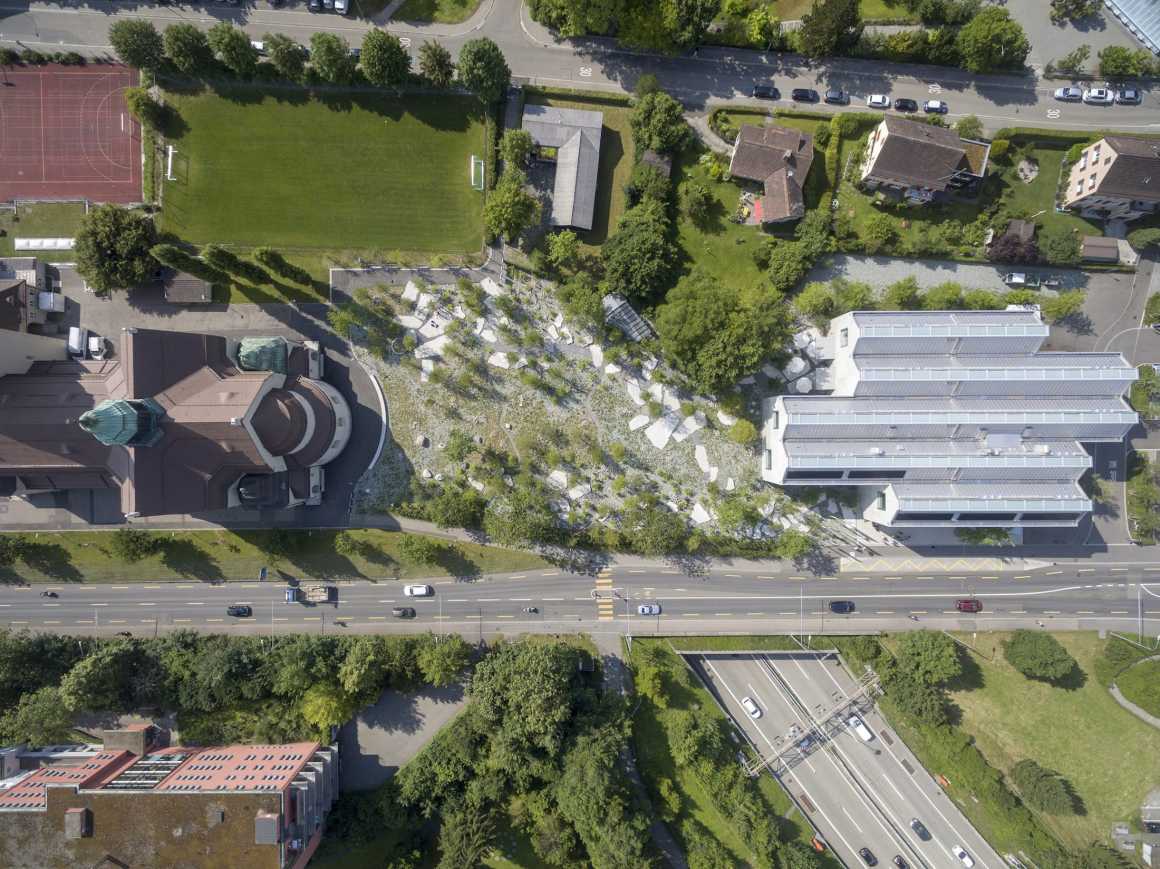
角梁树和凌乱茂盛的地被植物共同形成的自然基调和背景过滤掉了原本嘈杂的异质环境,让游客的精神沉浸徜徉在公园及其自然主题中。在这种基调背景下,承载着诗意和科学信息的巨大混凝土“垫脚石”,在连接交通的同时,也起到了一定的展示作用,就是这些散落在公园各处的石头碎片激发了我们的好奇心和想象力,于是我们从化石和冰川沉积的巨石旁边的混凝土板上凿出30厘米高碎片,并在上面标记了当地地质相关的地质科学术语。所以,与博物馆内部的线性教学方式不同的是,公园为游客提供了思考和体验无穷无尽的时间和自然演变过程的线索空间。
An atmospheric frame and backdrop of hornbeam trees and messy lush ground cover filter out the loud heterogeneous context, allowing visitors to mentally immerse themselves in the park and its play on themes of nature. Embedded in this atmospheric backdrop, enormous concrete “stepping stones” bearing poetic and scientific messages function as both path and exhibition. Strewn about the park, these fragments act as catalysts for our curiosity and imagination. Quotes and scientific geological terms of local geological relevance are chiselled out of the concrete slabs in 30 cm-high lettering, alongside fossils and massive boulders deposited by glaciers. Unlike the linear pedagogical approach inside of the museum, the park provides clues with which to ponder and experience the seemingly endless spans of time and transformational processes of natural history.
▼喷泉中的水象征着生命之源 The water in the fountain serves as a symbol of the source of life.
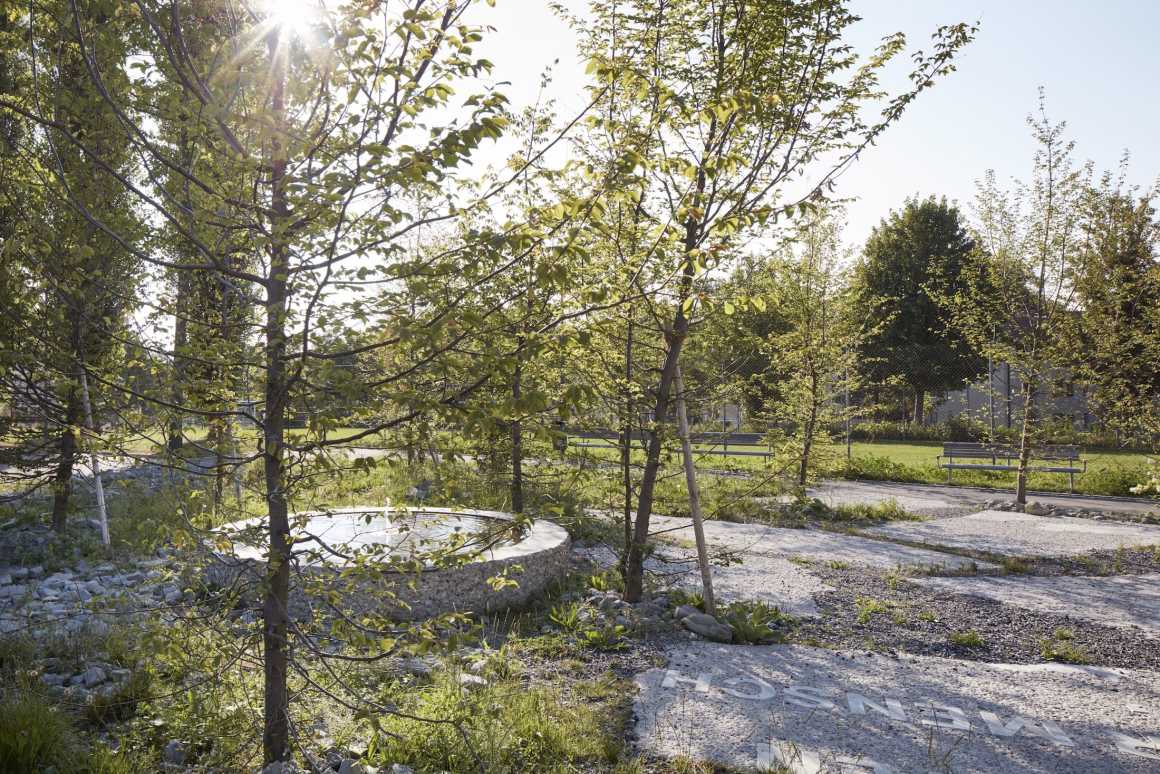
▼这里的景色旨在表明当地曾是”热带海洋” The landscape here is means that St. Gallen was once a tropical ocean

其中最重要的两种当地石材的表达出了自然与人类的关系,一种是人造混凝土,一种是同样存在于文化和历史建筑中的美丽绿色砂岩。虽然现在的砾岩和泥砾石的组成成分与人造混凝土完全相同,但混凝土铺装不仅能表达出它们与自然泥砾石之间的关系,同时也能展示出人类利用材料的能力(从粗锤、原始、自然到人工压印的各种铺装形式)。
整个公园的地面都由天然的砂石铺成,周围散落着由同种石材雕刻而成的精美文物。
The use of the two most significant regional stones express the relation between nature and mankind. The all present regional conglomerate, Nagelfluh, is identical in make-up to man-made concrete. The concrete pavers express both their relation to the natural Nagelfluh and the material’s ability to be formed by man, the surfaces appearing in all forms from roughly hammered, raw and natural to artificially imprinted. The beautiful green tinted sandstone is equally all-present in cultural, historical buildings.
The ground plane of the entire park is made of the stone a raw natural sandstone gravel while beautifully sculpted cultural artefacts of the same stone are strewn about.
▼瑞士东部常见的天然钉状混凝土与外观相同的人造混凝土材料,以及表现出人类起源图案的可塑混凝土 The omnipresent eastern Swiss “natural concrete” Nagelfluh is juxtaposed with the identical-looking, artificial building material concrete. The malleable concrete is shown, in addition to a natural-wild appearance, with patterns of human origin such as imprints of drainage mats or wooden slats
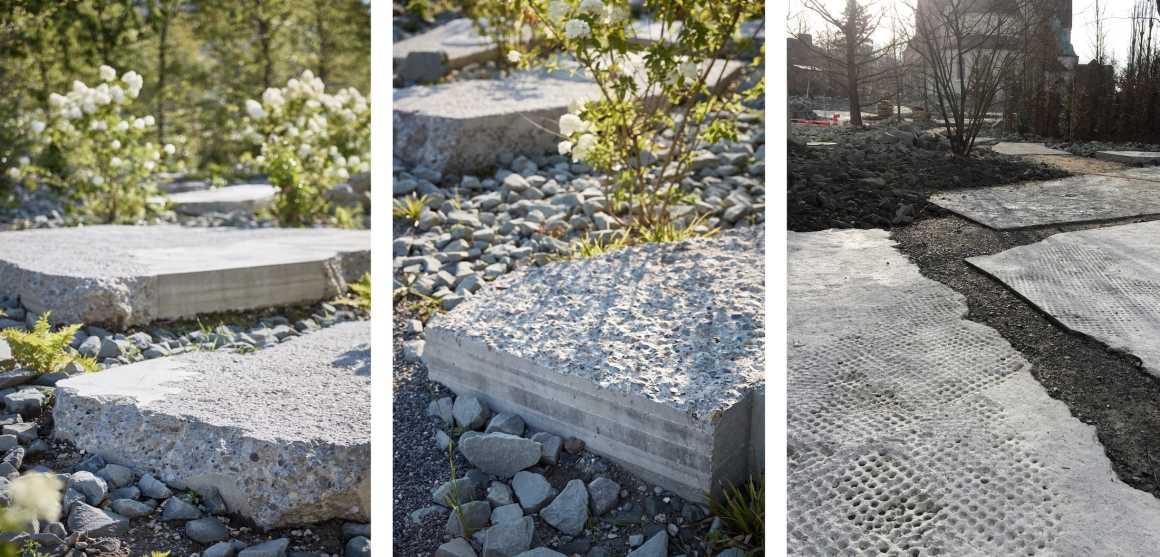
▼天然砂砾铺装中点缀着建筑文物 The ground plane of the entire park is made of the stone a raw natural sandstone gravel while beautifully sculpted cultural artefacts of the same stone are strewn about.
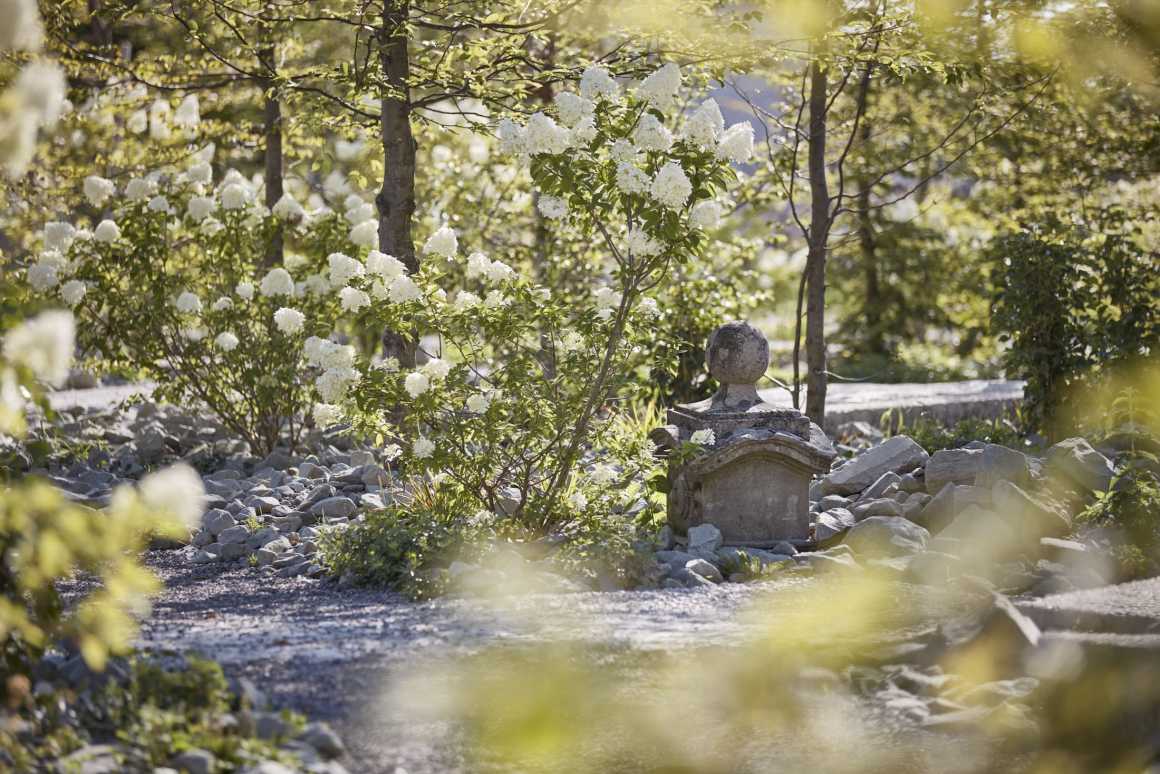
我们将地质历史的广阔维度浓缩在一个小而难忘的故事里,把瑞士东部的三个最重要的地质时代在公园中体现了出来。圣加仑岛曾经是一个热带海洋,是冰河时代的冰川把“Bahamas”、落羽杉和恐龙化石带到了只有米黄和灰色石头组成的地质区域,所以我们利用了彩色巨石来象征冰河时代的冰川,向人们讲述这一地质历史知识。
The three most significant geological eras of Eastern Switzerland are expressed in the park, encapsulating the vast dimensions of geological history in a small, memorable story. The fact that St. Gallen was once a tropical ocean is implied by such texts as “Bahamas”, bald cypresses and dinosaur fossils. Huge colourful boulders allude to the Ice Age glaciers that transported them to the region made up of only beige and grey stones.

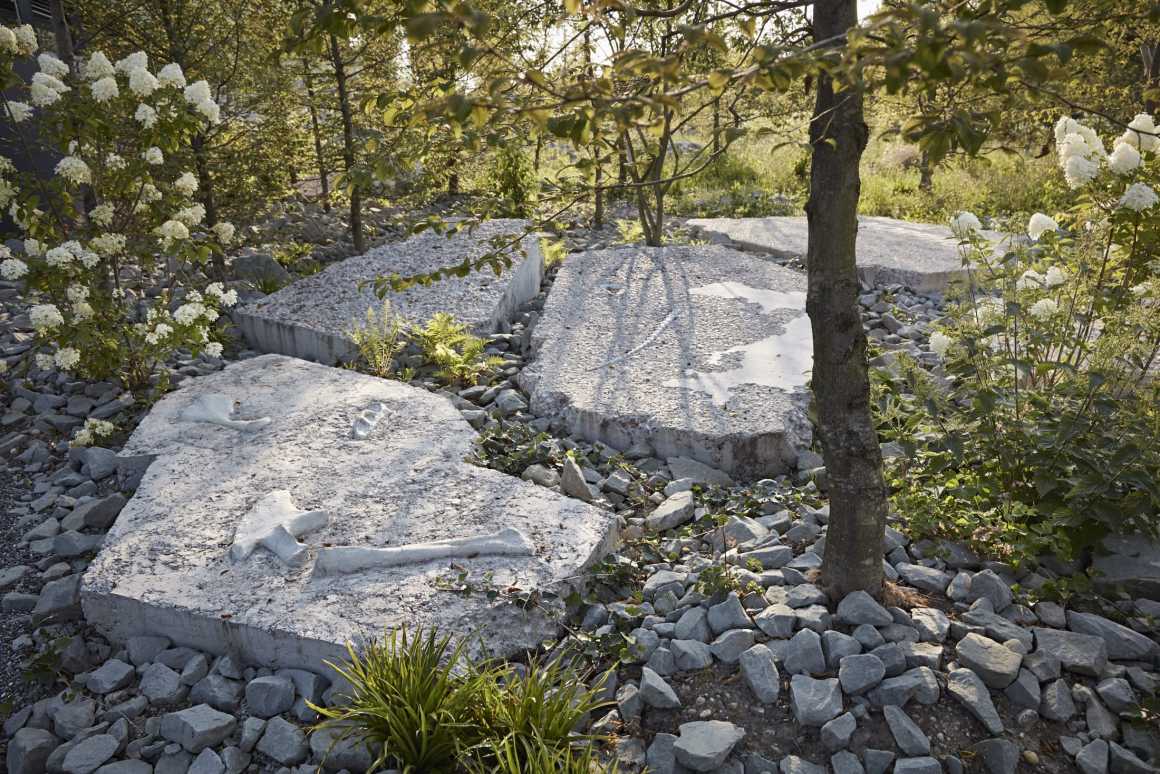
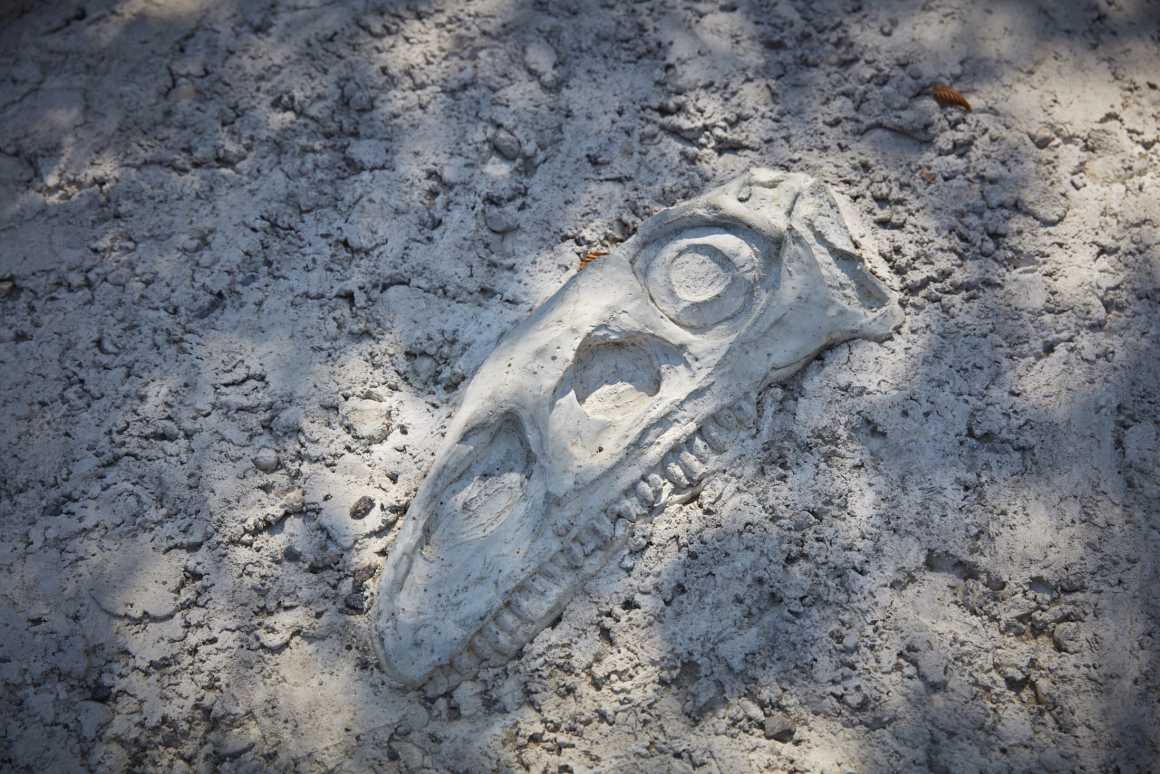
公园位于博物馆和圣玛丽亚·内多夫教区教堂之间,教堂要求我们结合两种创世界的理论——宗教和科学来设计景观,所以我们分别引用了《圣经》、马克思和达尔文的三句名言标记在混凝土板上。
The park stretches between the museum and the parish church of St. Maria Neudorf, which asked that the landscape design incorporate a dialogue on the two theories of the world’s creation, religious and scientific. Three quotes chiselled into the concrete from the Bible, Max Plank and Charles Darwin play on this theme.

植物设计也是我们展现公园自然主题一种手段。主要以本土植物为主,部分点缀着外来绣球花植物,这反映了公园矛盾的地理位置。博物馆正面的银杏和落叶松体现了大自然的谜语:银杏是世界上最古老的树,它有着精致的扇形叶,但却被归类为针叶树种,而且同样是针叶树种的落叶松,却会在冬天落叶,这两种树都会在春天释放鲜艳繁茂的绿色,也都会在秋天变成灿烂的黄色。
Vegetation also becomes a means to contemplate upon the park’s play on themes of nature. The predominantly indigenous plants are interspersed with non-native hydrangeas as a reflection of the parks paradoxical location. Ginkgo and larch trees in front of the museum façade embody a riddle of nature. The world’s oldest tree, ginkgo has delicate, fan-shaped leaves but is classified as a conifer. By contrast, larch is likewise a conifer, but loses its needles in winter. The two tree species share the vibrant neon green of their foliage in spring and the resplendent yellow hues in autumn.
▼完全融入落叶松和地被植物的超大混凝土石块,作为化石和文字载体,形成了公园道路 Oversized concrete stepping stones form a path through the park; they are bearers of fossils and texts
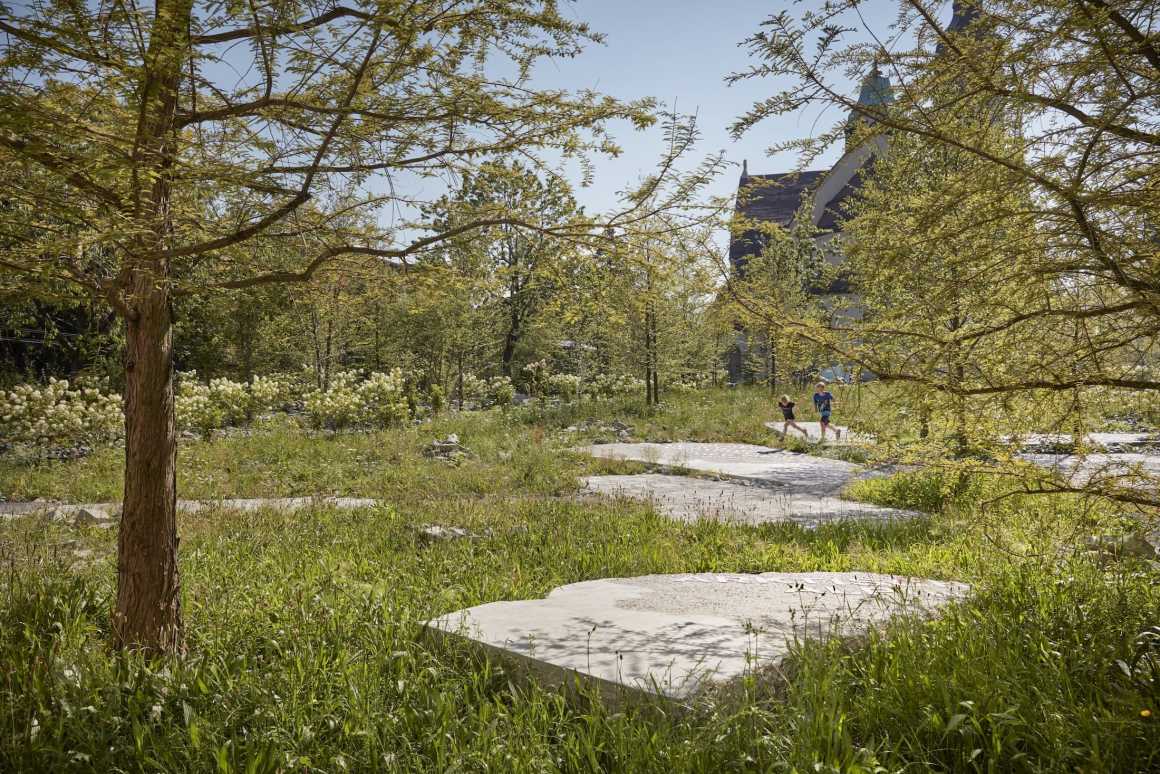
▼公园平面图 Site Plan
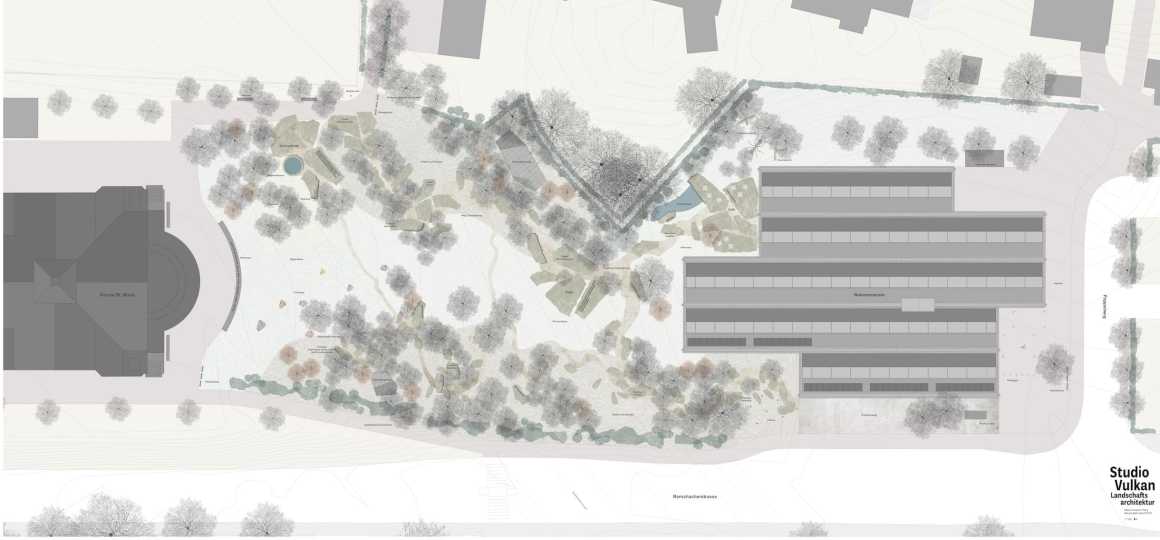
地点:瑞士圣加仑9016号,罗夏施街253号
面积:5000 m²
项目阶段:2009年竞赛一等奖
完成:2017 – 2018年
客户:圣加伦霍奇鲍姆特酒店
景观:Studio Vulkan (前身为Robin Winogrond Landschaftsarchitekten)
建筑:Armon Semadeni Architekten GmbH与Meier Hug Architekten AG合作设计
图片来源:Jean-Claude Jossen, Das Bild, Studio Vulkan
Location: Rorschacherstrasse 253, 9016 St. Gallen, Switzerland
Area: 5000 m²
Project phases: Competition 2009, 1st Prize
Completion: 2017–2018
Client: Hochbauamt St. Gallen
Landscape: Studio Vulkan (formerly Robin Winogrond Landschaftsarchitekten)
Architecture: Armon Semadeni Architekten GmbH, Zurich in cooperation with Meier Hug Architekten AG, Zurich
Photo credits: Jean-Claude Jossen, Das Bild, Studio Vulkan
更多 Read more about: Studio Vulkan




0 Comments